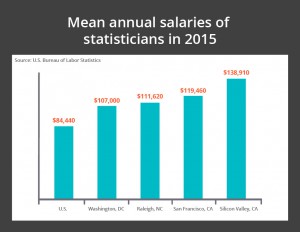Want Today’s Hottest Career? Start with a Statistics Course
July 8, 2016
Statistics is one of the fastest-growing jobs in the U.S. and a top job for Millennials. Students are catching on to its appeal – more are graduating with degrees in statistics, and taking AP statistics in high school.
 But what exactly is statistics and what do statisticians do? Statistics is the science of learning from data, and of measuring, controlling and communicating uncertainty. That translates into a lot of interesting jobs, from finding better medical treatments and understanding the impact of climate change on ecosystems to selling and delivering goods to consumers more efficiently and improving the performance of professional sports teams. Statisticians work in numerous fields —that’s part of what makes the profession so desirable.
But what exactly is statistics and what do statisticians do? Statistics is the science of learning from data, and of measuring, controlling and communicating uncertainty. That translates into a lot of interesting jobs, from finding better medical treatments and understanding the impact of climate change on ecosystems to selling and delivering goods to consumers more efficiently and improving the performance of professional sports teams. Statisticians work in numerous fields —that’s part of what makes the profession so desirable.
What Education Do Statisticians Need?
The degree and level of education a statistician needs varies widely depending on the individual, the sector and the job. A statistics degree is the most obvious path, but there are other paths, such as pursuing a degree in a different discipline and complementing it with many statistics courses.
For example, Shannon Cebron, a data scientist at a software company, has a bachelor’s and master’s degree in applied math and statistics. But Cassie DeWitt, an urban data scientist at the Detroit Fire Department, has an urban planning master’s degree with advanced coursework in statistics. Olivia Angiuli, a data scientist at the popular website Quora, has a bachelor’s degree in statistics.
Statistics jobs in research or academic institutions typically require a PhD. Professors Genevera Allen of Rice University and Roger Peng of Johns Hopkins University both earned PhDs in statistics.
More and more jobs today also require or benefit from knowledge of statistics, leading data-savvy graduates like Jeremy Singer-Vine to newly created positions such as data editor of Buzzfeed. Increasingly, professionals in marketing, finance and other parts of business also need to be statistically literate.
High school students interested in becoming a statistician should take courses in statistics, computer science, mathematics and science. English is also important, as statisticians often are required to communicate their results to decision makers without a math or science background, such as policymakers and business executives.
What does all this tell us? Students have a lot of choices in carving out an educational path for a career in statistics or a Big Data job. What’s most important now is taking that first step to enroll in a course.
Interested in seeing what other statisticians and data scientists are doing? Read more profiles of statisticians and data scientists, and some of the cool jobs they do.
Since we last spoke with our statisticians, Shannon Cebron now works at Backend Engineer, Cassie DeWitt is a director at Urban Data Science & Strategy, Olivia Anuguli works at SignalFire, and Roger Peng is a Professor of Statistics and Data Sciences at University of Texas at Austin.
Reviewed by the This is Statistics Team 06/2023
Related Posts

Hindsight Is 2023 for Former Statistics and Data Science Students
It’s back-to-school season! Gear up for the upcoming semester and consider diving into the captivating world of statistics and data science. Looking for diverse job opportunities that span across every industry? Look no further! With a variety of graduate programs and jobs, now is a great time for students to become data scientists and statisticians….

Elizabeth J. Kelly: “Statistics is for Adrenaline Junkies”
Elizabeth J. Kelly has always loved math, and as a professional statistician at Los Alamos National Laboratory (LANL) and a recreational rock climber, Elizabeth is an avid thrill-seeker who enjoys a challenge. “Math reminds me of climbing, including the need to focus, problem solve and persevere. I guess I ended up in statistics because I…

